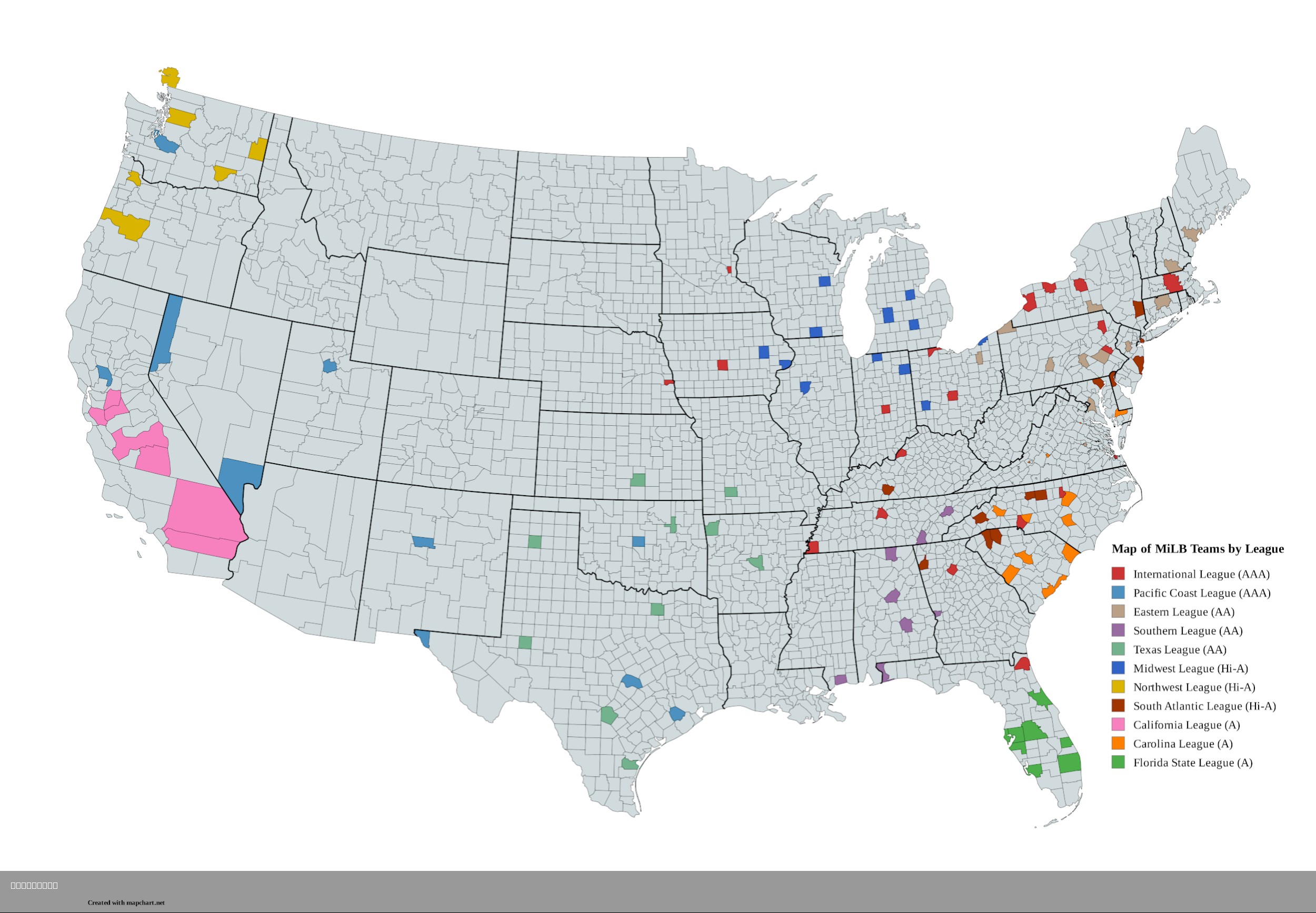Map of Minor League Baseball Teams by County Map


Marcus Rodriguez
Historical Geography Expert
Marcus Rodriguez specializes in historical cartography and geographic data analysis. With a background in both history and geography, he brings unique...
Geographic Analysis
What This Map Shows
This visualization displays the distribution of Minor League Baseball (MiLB) teams across various counties in the United States. Each county is color-coded to represent the presence of a minor league team, providing a clear view of where these teams are located. Minor league baseball serves as a vital feeder system for Major League Baseball, nurturing young talent and providing entertainment in local communities.
Deep Dive into Minor League Baseball Teams
Minor League Baseball has a rich history that dates back to the late 19th century, offering a platform for aspiring players to hone their skills before making it to the big leagues. Currently, there are over 160 minor league teams divided into various levels, including Triple-A, Double-A, Single-A, and Rookie leagues. Interestingly, the structure of these leagues allows for a unique experience for fans and players alike, as teams often represent specific regions or communities.
One key characteristic of minor league teams is their affiliation with Major League Baseball clubs. Each minor league team is usually linked to a major league franchise, which allows the bigger teams to send their prospects down for development. For instance, the Durham Bulls, a Triple-A team affiliated with the Tampa Bay Rays, have a storied history and are beloved in North Carolina. Their success and longevity illustrate the importance of minor league teams in American sports culture.
Moreover, the minor leagues are crucial for the local economies in which these teams operate. Minor league games are often affordable, making them accessible for families and fans, which drives attendance and local business revenue. Did you know that a single minor league game can generate thousands in local spending? From ticket sales to food and merchandise, the economic impact of these teams is significant.
Interestingly, minor league teams often have unique and quirky names that reflect local culture and history, adding to the community engagement. For example, the Albuquerque Isotopes and the Montgomery Biscuits are not just fun names; they are deeply rooted in their respective cities' identities.
In recent years, however, the landscape of minor league baseball has faced challenges, including contraction and the impact of the COVID-19 pandemic, which forced many teams to adapt to new realities. Understanding the dynamics of these teams and their communities is essential for appreciating the broader context of baseball in America.
Regional Analysis
When analyzing the map of minor league baseball teams by county, distinct regional patterns emerge. For example, the Southeast is home to a rich tapestry of minor league teams, with states like Florida and North Carolina boasting several franchises. In Florida, the state is a hotbed for minor league activity, with teams like the Miami Marlins’ affiliates, such as the Jacksonville Jumbo Shrimp, playing a significant role in the region’s baseball culture.
In contrast, the Midwest is also heavily represented, with states like Iowa and Illinois hosting numerous minor league teams. The Iowa Cubs, for example, serve as the Triple-A affiliate for the Chicago Cubs, creating a strong connection between the local fan base and the major league team. Comparatively, the West Coast has fewer minor league teams, with states like California having a mix of teams concentrated in urban areas, such as the Sacramento River Cats.
Interestingly, the Northeast region showcases a range of historic teams that have been part of the fabric of local communities for decades. Teams like the Pawtucket Red Sox (now the Worcester Red Sox) have left a lasting legacy, symbolizing the deep-rooted tradition of baseball in this area. Each region's unique representation highlights how local culture and demographics influence the popularity and sustainability of minor league teams.
Significance and Impact
The significance of minor league baseball extends beyond just the game itself; it encompasses community identity, economic impact, and player development. These teams serve as a crucial bridge for young athletes aspiring to reach the Major Leagues, providing them with invaluable experience and exposure. Furthermore, they foster community pride and engagement, as local fans rally around their teams, creating a sense of belonging.
In times of economic uncertainty, minor league teams have shown resilience. Their ability to adapt to changing circumstances, such as implementing safety protocols during the pandemic, demonstrates the importance of these teams in maintaining community connections. As we look to the future, the trajectory of minor league baseball will likely continue to evolve, reflecting broader trends in sports and society.
In conclusion, the map of minor league baseball teams by county is more than just a visual representation; it encapsulates the spirit of local communities, the journey of young athletes, and the economic vitality that these teams bring. As baseball continues to be America’s pastime, minor league teams will remain a pivotal part of the narrative, connecting generations of fans and players across the country.
Visualization Details
- Published
- August 6, 2025
- Views
- 100
Comments
Loading comments...